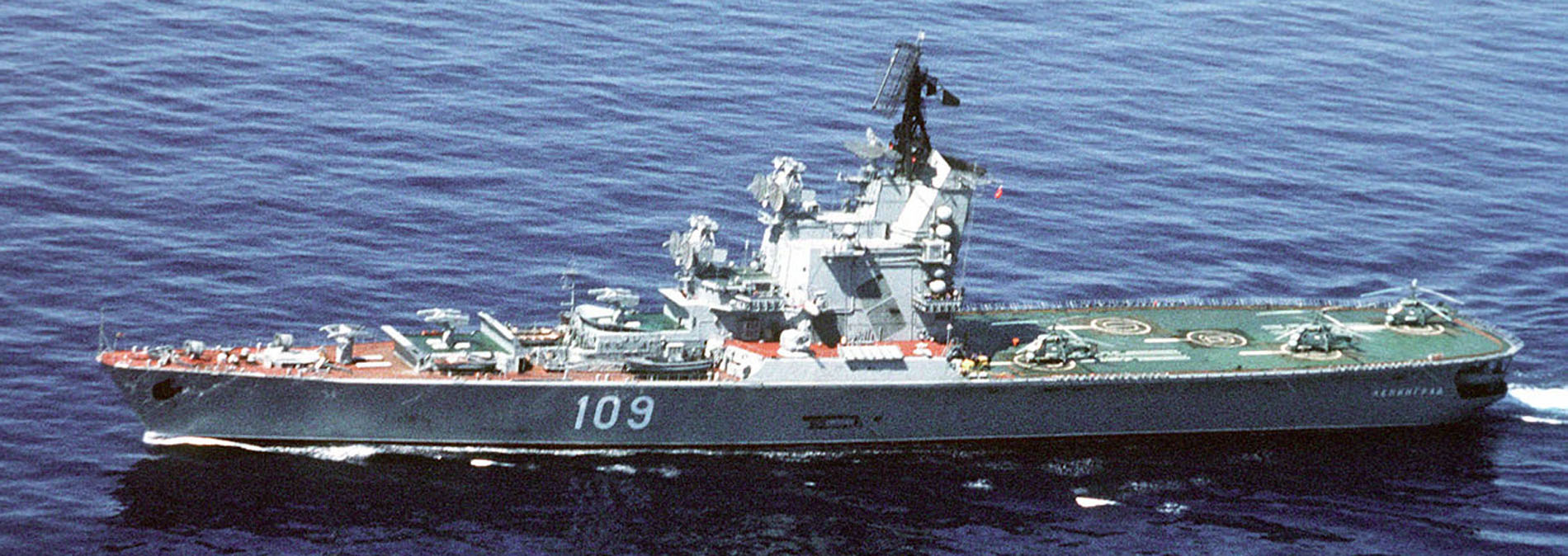
The Moskva and Leningrad were the first “aircraft carriers” built by the Soviet Union. They were perfect hybrids, combining the firepower of a cruiser foward with an aft flight deck, a configuration that was quite common at the time (Italians Doria, Veneto, Japanese Haruna, French Jeanne D’Arc, etc.). They were specialized ASW warships specifically dedicated to the destruction of American and British SSBNs. So they had to be able to implement large ASM patrol and fight helicopters in numbere to project them around the fleet, and models having a better range, such as the Mil-Mi14 “Haze”, up to 20 to 12 helicopters total to have at least 2-4 in patrol flight at all times. These were also the largest vessels ever built in the USSR since WW2 cancelled battleships, and became de facto ambassadors of the country overseas, especially in the Mediterranean. They were both based in the Northern Fleet, shortest oute for US SSBNs, but also cruised to other fleets. Issues with the design were corrected with the next Kiev class in 1968. They served until 1990, a year after Leningrad was stricken and Moskva in 1995. A third ship of the class, “Kiev” was laid down in December 1967 but Cancelled in 1969. #coldwar #sovietnavy #sovietskyflot #moskvaclass #helicoptercruiser
Development
A design studied from 1959 to 1962
Admiral Gorshkov initiated in specification first written in 1959 for these, but he insisted on the hull being as narrow as possible to keep a good top speed, whereas the design office replied that it would pose insoluble problems of stability and landing surface, capital for this type of ship. Gorshkov proposed for a moment the reconversion of one of the Sverdlov class and again, this was rebuffed for the same reasons. The TTZ specs were definitively adopted in 1960, opting for a large ship, very heavily armed for her own defense on all areas, air sea and underwater. Studies went on and and its only the 23rd project that was definitively adopted in 1961. This last one providing a park of 14 helicopters, of which a majority of Kamov Ka-25 and Mi-14, with enough stability to operate them by a sea of force 6- 7. They were housed in a hangar located between the two funnels, plus the larger lower hangar below the main flight deck, accessing by two elevators. There were also four spots for simultnaeous take-offs and landings.
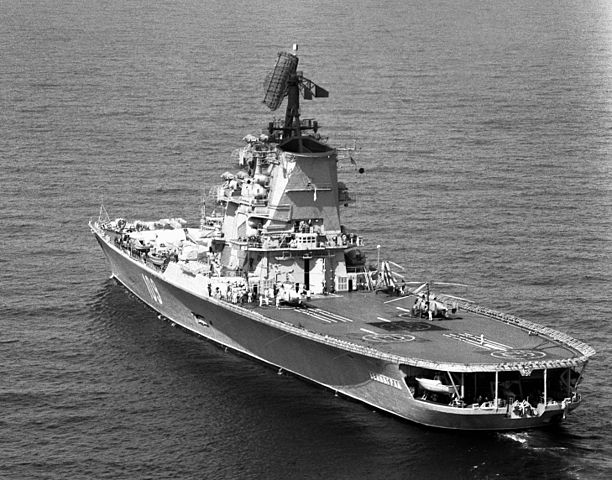
Dod Leningrad
Initially, they classified as “long-range anti-submarine warfare ships” but in 1966 there was a global reclassification and they ended to the subclass of anti-submarine cruisers. They were intended to combat strategic nuclear submarines or nuclear attack submarines in distant ASW defense zones from strike groups, in cooperation with other ASW ships plus ASW aircraft of the Navy such as the Tu-142 “bear”. Designers were tasked with a ship capable of round-the-clock search for submarines with four helicopters aloft at all times and in all weather conditions.
The final project name was “Anti-submarine cruiser-helicopter carriers”, Proyekt 1123 “Kondor”. The use of a name for a pretige program was new, and came out of reforms in denominations as well. They were were developed by Leningrad TsKB-17 (today Nevsky Design Bureau) under chief designer A. S. Savichev, and by 1967 his deputy A. V. Marinich. Captain 2nd Rank V.F. Fedin was all this time chief observer from the Navy, the eyes of the staff.
On December 31, 1958, the resolution of the Central Committee and Council of Ministers signed the “Plan for the design and development of an anti-submarine defense helicopter carrier ship (ASD) of Project 1123″, approving the shipbuilding program for 1960-1965. CiC S.G. Gorshkov preliminary design development was for a ship tailored to hunt down NATO SSBNs and SSNs in coordination with the long range naval aviation, and it was signified to the Main Directorate of Shipbuilding (GUK) at the head of all design and construction bureaus of the Navy. TsKB-17 was adopted based on calculations with optimal detection range for submarines of the Kamov-25 “Hormone” at the time (5.5 km), plus a radio communication range of 60 km, average search speed of 24 knots and a global operation capacity ported to 12-14 rotary wings.
On January 25, 1960, after much discussions the TTZ was approved, coming up with an optimistic initial displacement of 9,500 tons for 32 knots, 14 Ka-25 in part plus intensive ASW and defensive suite. Exactly two years later, on January 25, 1962, the Navy approved project 1123, but had it raised to a more sensible 10,600 tons given stability calculations, and also reduced top speed of 29 knots (much to the annoyance of Gorschkov) had modified hull to increase seaworthiness for stability up 6 points. MI-8 helicopters were now added to the park (later replaced by a properly marine derivative, the Mi-14), as well as the new SAM system “Vikhr”, two medium-range SAM “Storm”, two short-range “Osa”, two twin 57-mm AK-725, two RBU-6000, two quintuple torpedo tubes, a new, large and innovative communication suite, fagship accomodations, and a crew of 415, excluding helicopter crews. In reality it will rise to 1200+.
In the meantime, NATO’s SSBN’s Polaris missile range doubled, forcing Krushchev to review the Soviet ASW defense: The radius of action of the new project and its on-board park were to be increased: 26 other modifications were made to the plans before Moskva was ordered at Nikolayev in December 1962 when the final draft was approved. Moskva was launched in January 1965, completed in December 1967, trials officially starting by August 1967. Leningrad replaced her in the same dockyard by January 15, 1965. She was launched in turn by July 1968, completed in 1969.
An innovative design
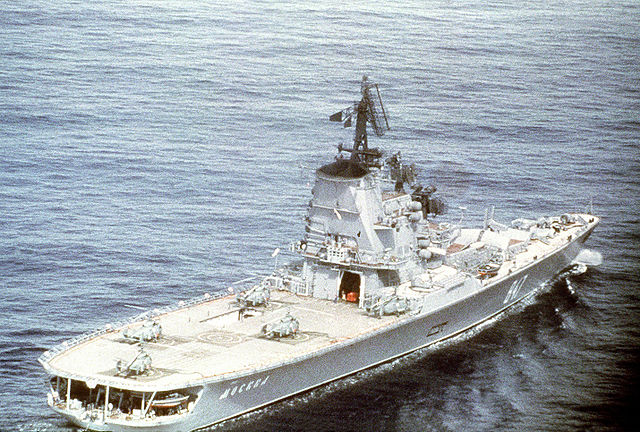
The Moskva-class helicopter cruiser, also known as Project 1123 Kondor, was a class of Soviet naval vessels combining advantages of a conventional missile cruiser with a flight deck to provide an extended anti-submarine warfare capability to the fleet. It was to also operate helicopters for other purposes such as including reconnaissance, datalink for antiship cruise missiles relay, and assault. Initially their aim was to counter NATO Polaris submarines, and they had to received all flagship facilities to lead an anti-submarine warfare group or task force.
Primary role was anti-submarine warfare, equipped with sensors and weapons systems to primarily attack enemy submarines, aboove all else nuclear ballistic ones. For Helicopter Operations they were tailored to carry up to eight Kamov Ka-25 or Ka-27 helicopters, which could be used for ASW, search and rescue, anti-ship missile targeting, and other tasks. And they were armed with a combination of surface-to-air and anti-ship missiles, as well as guns for self-defense. Prirary assets were the P-500 Bazalt anti-ship missile system and the S-300F Fort-M surface-to-air missile system.
Displacement rose to 14,000 tonnes standard and 16,000 tons fully loaded, making them the largest vessels built in the Soviet Union since 1940.
They were powered by a combination of gas turbine and diesel engines for a top speed of 32 knots. Crew complement varied between 1,100 in normal conditions, with enough space for 100 more as flagship, with the relevant accommodations for a small contingent of marines for potential amphibious operations.
Design of the class

Hull and general design
They displaced 11,920 tons standard and 15,280 tons full load for a lenght of 189 m (620 ft), Beam of 34 m (112 ft) and draught of 7.7 m (25 ft). Seen from above, the “pear shape” of their hull is self-evident, an obligation to preserve a relatively measured beam and still give a large, roomy flight deck woith large spots series side to side for the largest Soviet helicopters in operations. Seen from the profilen they look stunningly modern, almost spaceship-like due to their tall, staggered superstructure combining funnels, sensors and bridges, then weapons systems down to the deck. The structure ends abruptly to the flight deck, giving them an instantaneously recoignisable silhouette for all NATO pilots and bridge officers.
A very unique and peculiar hull shape
The cruiser’s hull was welded from steel with longitudinal framing spaced by 500 mm for ice resistance reinforcements. The bow had a V-shape which went on all the way to the aft section providing a large camber for required flight deck area aboard of 2200 m², protection from water spreay, and still a sizeable hangar space below. The hull belly had a forward underkeel Orion retractable sonar antenna close to the bow, while a towed Vega sonar could be lower down from the stern. The hull was divided into upper and middle decks, and in the bridge, four platforms, hold and a second deck, plus bottom. There was a double bottom extending throughout and ended in a rarrower doubled side for ice pressure (it punctured, water would just seeped in the lower double hull), whereas the double bottom space was heavily compartimented to serve as fuel and drinkable water storage.
The upper and middle decks were continuous with the upper one having a break up to the bow for seaworthiness. The hull’s sides were clean, without knuckle and with a much superior volume compared to the underwater hull, meaning buoyancy was excellent. There was an initial transverse metacentric height issue with the large fairing of the Orion sonar that extended 0.87 m below the keel. It was 1.73 m lower in normal displacement, 2.2 m on full displacement. But more than the hull, the superstructure bridge, multi-tiered, combined with an ending funnel and tower-like pyramidal foremast made of lightweight alloys, gave these Moskva class cruisers a spectacular appearance, intimidating and commanding presence. This was a consequence of the design to maximize the arc of fire forward but also became ideal of flagship use and to “show the flag”, reassuring friendly nations across the globe.
Front and Rear View, Leningrad
Protection and survivability
The hull was basically unprotected. Underwater protection consisted only from compartments with corrugated longitudinal and transverse bulkheads, bottom and side tanks of special design toabsorb torpedo blasts, placed in such a way the ship would maintain stability after any combat damage. All main and auxiliary systems in addition were placed mounted inside the hull on foundations using shock absorption systems, not only to insulate these from blasts and vibrations, but also reduced noise and the ship’s own acoustic signature to NATO submarines.
The underwater external hull was covered with six layers of ethinol paint EKZhS-40, with preliminary cold phosphating, combating fouling but also creating some electric field insulation. There was ageneral absence of portholes, and instead forced ventilation throughout, with corridors accessing all combat posts without the need to wask the upper deck, ensuring completed NBC protection.
On this chapter, the nuclear/chemical protection system ensured complete sealing of the ship in combat for three hours, using filter ventilation and an irrigation system to wahs over superstructures and decks, also usable in case of an external fire, like on the helideck.
Ammunition holds throughout the ship had automatic fire extinguishers (see later, pumping systems).
Interior
Living quarters were located mostly in the stern, bow, but also amidship, in three-tiered stationary beds in varying capacity cabins. Personal belongings and uniforms were stored in lockers. Meals for conscripts were inside their cabins, provided folding tables and benches, cupboard and tank with drinking water. Officers and midshipmen had larger cabins amidship and close to the bridge, or bow, as well as in the superstructure for higher echelons. All cabins had air ventilation systems and intercom. Officers and conscripts took food in the wardrooms, three at various locations, separated for officers and midshipmen.
The supply of provisions and other equipments needed special storerooms, a refrigerator set to −18°C, but also the best accomodations ever seen in a Soviet ship so far: Baths, showers, laundry, hairdressing, library, cinema, and improved washrooms and latrines offering more privacy. The medical block included an infirmary, isolation ward, operating room, outpatient clinic. The ship had a large fresh water supply pumped out from the double bottom tanks, which were replenished using water from two desalination plants.
For crew’s rescue, there the following:
-Main Command/liaison boat (Project 1390 “Strizh”, 7.8 m long, gasoline engine powered 55 hp)
-Motor rescue boat Project 1394A (11 m long, 60 hp)
-Two work boats project 1391 (8.5 m long, 40 hp diesel)
-Two 6-oar yawls
-48 inflatable 6-seat life rafts PSN-6 and about 900 lifebuoys.
Main Boats were located side by side on the upper deck close to the second Storm SAM under shifting side shutters and aft part of the open middle deck under the helideck.
Interior Compartments
cutaway awaited
There were 16 compartments (for each bottom to top): Reinforced ice-cutting Bow with forward fuel oil tank, Trim tank and chain storage, Fuel oil tank and various storerooms, forward pitch stabilisation tanks and another with fuel oil, storerooms, forward pump compartment and various posts, another fuel oil tank cofferdam, missile storage for the Shtor SAM, “Orion” sonar compartment and on-board tanks, Feedwater tanks and cofferdams, fuel oil tanks, ammunition room for the Storm SAM plus onboard refrigerators, fuel oil and side tanks, side cofferdams, forward engine and boiler room then power compartment, side and belly fuel tanks plus cofferdams, first powerplant room, rudder drives for pitch and side rudders, pitching stabilizers and the same as above as well as the main air presure generator and main combat station, right refrigerator. Next came the same fuel tanks (side, bottom, cofferdams) but two storerooms, aft engine and boiler room, aft Feedwater tanks, aft power compartment and aft main powerplant. Then came the main pump room, kerosene storage, nitrogen cylinders, storerooms for depht charge and torpedo warheads. Next came the aftermost on-board refrigerator, another warhead storage toom, steering gear room, “Vega” VDS sonar room and another warheads and buoys storerooms. The hull was calculated to remain afloat when three adjacent compartments were flooded, even separated by main watertight bulkheads, or four bow compartments forward of the frame 61.8.
Other protection systems
There was a consistent fire-fighting system using gas-freon fire extinguishing stations, and a water fire-fighting main with many outlets across the hangar, ammunition storage rooms, and eight fire pumps, foam extinguishing agents projectors with smoke and heat detectors, and high-speed irrigation (“flash flood”) of ammunition magazines, the “Karat” automatic fire extinguishing system. It could also flood less sensitive ones located below the waterline.
The drainage system included stationary electric pumps NVTs-630/15 located in the bow and stern compartments. There were alsi for damage parties portable submersible drainage pumps ESN-16/P and portable ejectors VEZH-21. All water systems could operate from Key automated control system or remote control with electric pulse of water protection valves backups, and also for the fuel reception and pumping or cooling and ventilation systems.
Powerplant
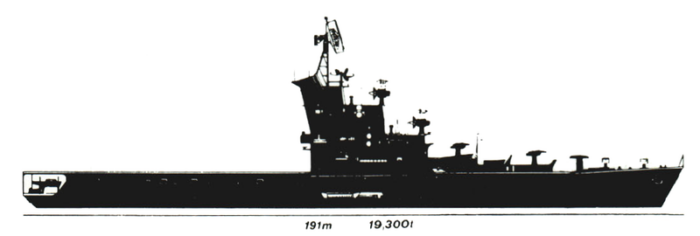
The powerplant was a mixbag. Gas turbines were considered from the start and still untried in such large vessel. The second class where this was attempted (at the core of the design) were the Kara class ASW cruisers. Eventually the command decided for a less risky approach and to matty with the system two high pressure steam boilers arrangements similar to those on the the Kynda-class cruisers:
2× fixed pitch propellers
2× 45,000 hp TV-12 steam turbines
2× 1,500 kW TD-1500 turbine-type generators
2× 1,500 kW diesel-generators
Their two 45,000 hp TV-12 steam turbines were coupled with two fixed pitch propellers, and the system also relied on two 1,500 kW TD-1500 turbine-type generators, and two 1,500 kW diesel-generators ensuring top capabilities when the main steam engines were cold. She was able to reach 28.5 knots (53 km/h) and an endurance of 15 days for her 850 crew, quite larger than initiallt planned, but including all the helicopter crews and maintenance teams.
Their turbines and boilers developed severe problems during their career, so they had to be replaced in 1973 following a fire. Operational performance was sub-par with expectation, which was originally 30 knots (56 km/h; 35 mph) 28.5 knots best recorded on trials, light, and 24-knot (44 km/h; 28 mph) maximum sustainable speed in combat. Sea keeping also proved more disappointing that expected, despite all measures taken. The ships had a 9,000 nautical miles (16,668 km) range at 15 knots (28 km/h) but an endurance of only 15 days limited overseas deployments
Steering and roll control
The steering system consisted of a main electro-hydraulic drive controlling one semi-balanced steering wheel. It had a power drive, two main power units, one backup of equal power, and the remote electric automatic steering system “Albatross”. There were many control and alarm panels with starting equipment, steering wheel position indicator, fill/draining hydraulic systems all connected with three-phase alternating current 50 Hz 380 V. Controls could be switched to “Automatic”, “Tracking”, “Simple”. Thise enable the rudder to turn from 35° of one side to 30° of the other side in c25-28 seconds.
Side rudders for pitch control system with variable angle counterkeels depending on the motion also greatly improved the ship’s stability in adverse conditions. The roll control system was automated also with a Rul-63 control equipment with its own rudders and flaps traversing at 15 seconds at full angle. This was monitored remotely from an external post. It could massively reduce roll between speed from 5 to 22 knots so to allow operations in stormy conditions.
Anchors
The anchor system ensured accelerated fall without personnel present on deck, so remotelly, and included two main anchors and chains, were fastened with stoppers recessed into the hull to reduce splashing. Two anchor-mooring capstans with electric drive are installed on the forecastle for more detailed mooring operations and main dragging/dropping of the chains.
Armament
Anti-Air
Two twin M-11 Shtorm (NATO SA-N-3 ‘Goblet’) SAM
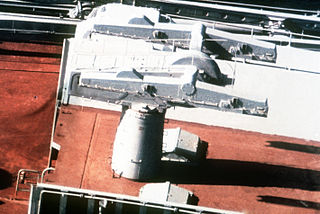 The M-11 Shtorm (“Storm”) was a surface-to-air missile system (GRAU 4K60; NATO SA-N-3 Goblet) first installed on Moskva but not officially accepted until 1969 an solely deployed on Russian vessels, never used in combat. Development started on 25 July 1959 by Scientific Research Institute 10 (NII-10) until 1966. Its launch platform used a twin rail naval Mount with below deck magazine. The missile along weighted 1,844 kg (4,065 lb) for 610 cm (240 in) long, carrying a 80 kg (180 lb) warhead to 30 km (19 mi) or a ceiling of 25,000 m (82,000 ft) at Mach 3. It was seen as rough equivalent of the USN Talos. They were located on upper platforms aft of the ASUW launcher, stagerred in front of the bridge.
The M-11 Shtorm (“Storm”) was a surface-to-air missile system (GRAU 4K60; NATO SA-N-3 Goblet) first installed on Moskva but not officially accepted until 1969 an solely deployed on Russian vessels, never used in combat. Development started on 25 July 1959 by Scientific Research Institute 10 (NII-10) until 1966. Its launch platform used a twin rail naval Mount with below deck magazine. The missile along weighted 1,844 kg (4,065 lb) for 610 cm (240 in) long, carrying a 80 kg (180 lb) warhead to 30 km (19 mi) or a ceiling of 25,000 m (82,000 ft) at Mach 3. It was seen as rough equivalent of the USN Talos. They were located on upper platforms aft of the ASUW launcher, stagerred in front of the bridge.
Two twin 57 mm AK-725 (2.2 in)/80 guns
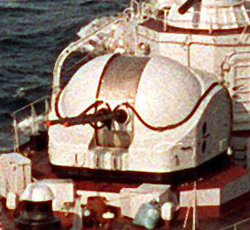 The AK-725 was the Soviet universal twin naval artillery mount, second post-war generation. It was first designed by Chief designers A. I. Arefiev and P. A. Tyurin and entered service in 1964. It was standardized in the 1960s-1970s, on many types and widely exported abroad. Significant drawback was insufficient effectiveness against anti-ship missiles. They were located on platforms either side of the rear superstructures forward-amidships.
The AK-725 was the Soviet universal twin naval artillery mount, second post-war generation. It was first designed by Chief designers A. I. Arefiev and P. A. Tyurin and entered service in 1964. It was standardized in the 1960s-1970s, on many types and widely exported abroad. Significant drawback was insufficient effectiveness against anti-ship missiles. They were located on platforms either side of the rear superstructures forward-amidships.
The twin turret was coupled with a MP-103 Bars radar fire control system with backup remote control post. It could be also used against surface and ground targets, and was related to the famous self-propelled “sparka” (ZSU-57-2) of the Soviet Army. It was provided with a belt feed for an excellent rate of fire of 400 rounds per minute. It fired 2.8 kg unitary rounds with fragmentation tracer and contact fuses and there were 1000 in reserve on belt. Range was 13,000 m, muzzle velocity 1,020 m/s. Cooling used sea water. The turrets weighted 17.3 tons.
Two 45-mm 21-KM semi-automatic guns
These were 1930s guns still used as saluting ones. Late version 21 KM used, until 1975. In the worst case they could be used for close defense. Total weight 507 kgs, 85° elevation at 10-20° sec. manual and 10-18° for a 360. Range 9,200m cailing 6,000m crew 3, 300 rounds. Could also fire illumination shells. It is unsure where they were located, probably amidships along the superstructures.
ASW
Twin Vikhr launcher (NATO SUW-N-1 FRAS-1) anti-submarine missiles
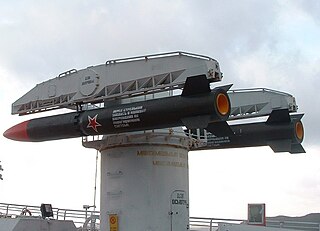 The RPK-1 Vikhr (“Whirlwind”) (GRAU 82Р, NATO FRAS-1) is a Soviet ship-based anti-submarine missile system adopted on June 12, 1968, studied 1960-66. So it was also inaugurated by the Moskva class. It has an inertial guidance system. It carried a tactical nuclear warhead (5/10 kt) with complete obliteration at any target over a 1.2 to 1.5 km radius.
The RPK-1 Vikhr (“Whirlwind”) (GRAU 82Р, NATO FRAS-1) is a Soviet ship-based anti-submarine missile system adopted on June 12, 1968, studied 1960-66. So it was also inaugurated by the Moskva class. It has an inertial guidance system. It carried a tactical nuclear warhead (5/10 kt) with complete obliteration at any target over a 1.2 to 1.5 km radius.
Weight of the missile 1800 kg, 6.00 m long, 0.540 m diameter, Solid fuel engine, Range 10-24 km. The alternative was a 450 mm (18 in) non-homing torpedo. This was the “ultima ratio” against any USN sub -provided the sonar picked it up.
The system was dependent of the Sprut fire control system (PUSTB-1123) developed by CDB-209, comprising a central control unit (TSPUS), Tiphon fire control computer, Gyro stabilisers, Link to the sonar system and Remote power control. It was located immediately after the RBU rocket launchers forward,
2× RBU-6000 ASW rockets
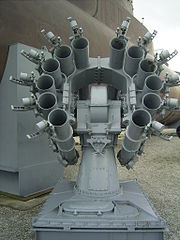 A “classic” already covered in other articles. They were located forward on the deck, close to the bow. Weight: 3,100 kg (empty), 2 m long, 2.25 m height 1.75 m width, -15° to +65° elevation and 180° traverse.
A “classic” already covered in other articles. They were located forward on the deck, close to the bow. Weight: 3,100 kg (empty), 2 m long, 2.25 m height 1.75 m width, -15° to +65° elevation and 180° traverse.
Fires the RGB-60, 0.212 x 1.83 m, 113.5 kg, Warhead 23 kg, range 350 m to 1700 m or 1500 m to 5500 m, depth capacity 500 m with 11.6m/s sink rate.
2×5 553 mm (22 in) torpedo tubes
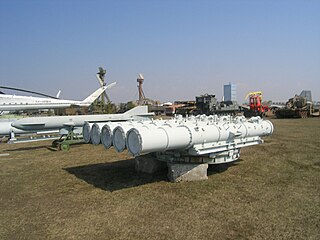 These quintuple torpedo tubes banks PTA-53-1123 using remote-controlled electric servo drive with backup manual drive. The rotating platform enabled loading, aiming and traveling with fire control firing data into the torpedo, of the SET 53-65K type. It was a pneumatic launch as powder charge was judged too risky.
These quintuple torpedo tubes banks PTA-53-1123 using remote-controlled electric servo drive with backup manual drive. The rotating platform enabled loading, aiming and traveling with fire control firing data into the torpedo, of the SET 53-65K type. It was a pneumatic launch as powder charge was judged too risky.
The SET-53-65K entered service in 1969, weighting 4,563 lbs. (2,070 kg) for a lenght of 283 in (7.200 m), carrying a 661 lbs. (300 kg) warhead (conventional/nuclear). It was powered by a Kerosene-Oxygen Turbine at 20,800 yards (19,000 m)/45 knots.
Sensors
Air/surface Radars
-MR-600 ‘Voskhod’/MR-310 ‘Angara-A’ air/surface radar
-‘Don’ navigation radar
ASW
-MG-342 ‘Orion’ or MG-325 ‘Vega’ sonar
-MG-26 ‘Khosta’ underwater communication system
Electronic Warfare/Com
-2× ZIF-121 rocket launchers (PK-2 decoy)
-‘Gurzuf’/’Gurzuf-1’ ESM radar system
-MRP-11-16 ‘Zaliv’ ESM radar system
-‘Kremniy-2M’ IFF
-ARP-50 radio direction finder
-MVU-201 ‘Koren-1123’ combat information control system
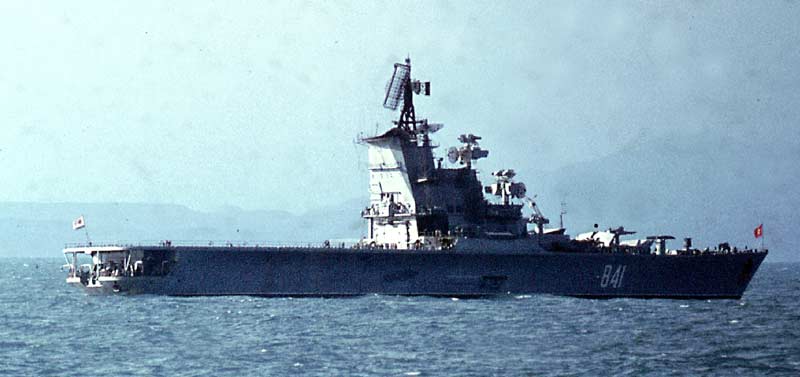
The “Don” navigation radar had an antenna post and was intended to illuminate navigation routes and solve problems, enterring service in 1957. It can operates in the 3 cm range, detect surface objects at 50 miles, airborne at 25 miles. It is placed on a special platform on the mast with a surface detection range depending on the height of the antenna above sea level.
The MP-310 “Angara-A” displays airborne and surface situation, detecting air and surface targets, determine range, azimuth and elevation with the data transferred to the fire control system. It comprised an Antenna post, Radio technical blocks, CRT indicator with Remote indicator. It is a three-dimensional radar with two channels, operating in circular, sector, and target tracking modes. To reduce measuring errors with angular coordinates, facilitate operators life when the ship is rolling, there is a stabilization system on 3 axles on to the guidance drive circuit. The remote indicator is located on the command bridge/conning tower and could after VIKOTS upgrade, determine deviations in artillery and rockets splashes.
Frequency range is 10 cm, overall detection range 200 km, Azimuth 360° elevation 55° rate 5-10 sec, 56 km surface range.
Facilities and Air Group
Facilities
The hangar under the flight deck had a unique design and an internal volume of about 12,400 m³ with minimum supports in order to move around and accommodate 12 KA-25PL helicopters, blades folded. At the stern it was closed with shutters, leaving space for an open aft deck below the aft flight platform, allowing to open the shutter to get fresh air into the hangar under hotter climates, but also moved helicopters out of hangar. The aftermost lift was close to this hangar’s end, to starboard, with a spot right behind, both usable as rapid taking off spots. The second lift was located closer to the bridge, port, again close to the forward taking off spot. There were two other landing spots of the same size with forward arrow markings port and starboard.
The second hangar located under the main bridge structure was housing two helicopters side by side.
Helicopters aboard
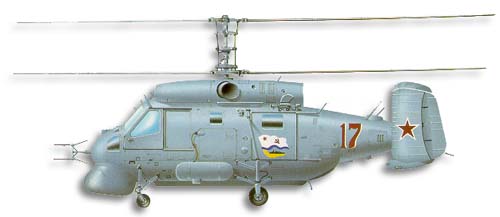
18× Kamov Ka-25 ‘Hormone’ or Mi-8 helicopters when used for transport missions. The Ka-14 “haze”, capable of landing at sea, was also operated. The Ka-25 Hormone is the standoff ASW helicopter of the Soviet Navy, replaced by the Ka-27 in the 1990s.
Full article on the Ka-25 Hormone
It should be noted that Moskva had a strong deck, and thus on November 18, 1972, she was able to test for the first time landing and take offs from YAK-38 VTOL aircraft, testing the concept and starting qualifying pilots for the future Kiev class in construction. This enabled another capability in case of war. However nothing aboard was setup to service these planes.

Author’s illustration of the Moskva
⚙ specifications |
|
| Displacement | 11,200t, 17,500t FL |
| Dimensions | 189 x 23 x 8.5 m |
| Propulsion | 2 shafts VHP turbines, 4 HP heaters, 100,000 hp. |
| Speed | 30.5 kts (nominal, 24 realistic, 15 cruise) |
| Range | 9,000 nm at 20 kts. |
| Armament | 2×2 SAN-3 (44), 2×2 57 mm, 1×2 ASUW-N1 (12), 2x RBU 6000, 2×5 533 mm TTs, 12-14 Helicopters. |
| Sensors | Top Sail Radars, 2 Head Light, Head Net-C, 2 Muff Cob, 2 Don-2, 1 Moose Jaw Sonar, 1 SPV Mare Tail, 8 CME Side Globes, 8 Bell, 2×2 chaff RL. |
| Crew | 850+ |
General Assessment
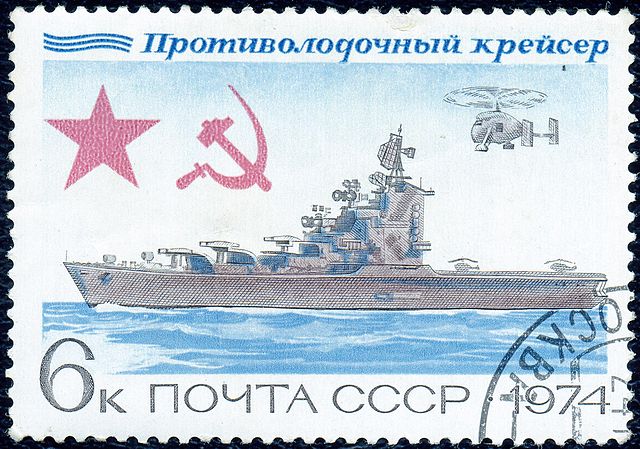
Commemorative stamp.
As a Lead ship commissioned in the 1960s, she started service followed by Leningrad, modified with the early lessons learned with Moskva as issues appeared, upgrades and modifications were needed. Depite their flaws, the design marked a unique approach to naval warfare, combining the roles of a cruiser and an “aircraft carrier” which was a great advanced towards the type in Soviet inventory. While the class itself was limited to just two ships, it contributed to the development of future Russian naval vessel designs, with new studied launched for a different approach as soon as their own design was completed in 1962 and after early service reports in 1966-67.
Weapons and sensor suite was optimized against US nuclear submarines and between the “Mare Tail” variable depth sonar and heliborne sensors the really were ideal to to hunt down NATO submarines. On 2 February 1975, a fire in the Moskva’s bow caused severe damage and she needed one year of repairs. She stayed service until the late 1990s, being decommissioned in 1996 but scrapped a few years later. Leningrad was a bit more active. She operated with the Black Sea Fleet from 9 July. On 1-31 May 1970, and between 1 December 1971 and 30 June 1972, then 15 June to 6 December 1974 she made Mediterranean cruisers and supported Egyptian forces during the Yom Kippur war. From 4 August to 14 October 1974 she became flagship of the Suez Canal mine clearance task force. In August-November 1984 she took part in minesweeping operations in the Red Sea and the heavily contested Bab-el-Mandeb area, up to the Gulf of Aden. Between 31 May and 7 June 1990 she resumed her ASW exercizes in the Mediterranean. She also rescued a submarine by February-March 1972. She visited Dakar in 1974, 1976, and Algiers in 1981, Havana in 1984 and had two large refits, in 1977-1978 and 1986-1987 at Sevmorzavod. In 1989 she was awardered the CiC prize in the anti-aircraft category. On 24 June 1991 she was decommissioned, the crew being disbaned and by 24 August 1995, towed to India for scrapping.
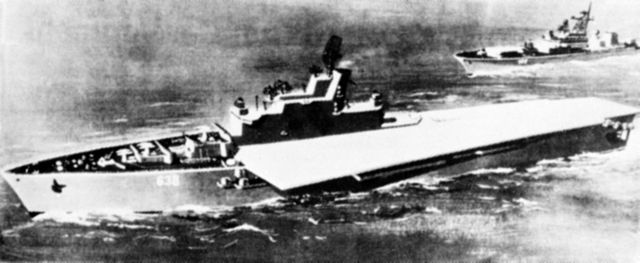
Artist impression of the next Kiev in the late 1960s.
This led to the design of a new project combining helicopters but also carrier VTOL aircraft and ultimately led to the design of very different ships, the Kiev class, still hybrids combining the best of both worlds but with a transverse flight deck alongside the main superstructure instead of aft of it. This was merely the result of the enormous air draft created by the superstrcture aft end, at the foot of the deck. This mass indeed created violent drafts that were dangerous both for both landing and taking off, esppecially when the wing came from forward. When funnels on both sides, it created a pressure differencial that was in principle made for shielding helicopters, but proved detrimental in the end as the wind rushed back on both sides, caughting any helicopter airborne low enough and causing severe turbulences.
The next Kiev class with their unusual, long albeit lower, but massive superstructure aslo created its own issues, leading ultimately to the long postponed project (for doctrinal reasons going back to Khrushchev and Gorshkov) of a full-deck carrier, the Kuntetzov class.
 Moskva
Moskva

Moskva was Laid down at Nikolayev South Shipyard No.444 under serial number 701, launched in 1965, commissioned in 1967. Trials showed poor handling in rough seas.
On December 25, 1967 she entered service as part of the Black Sea Fleet (21st brigade of anti-submarine ships) and not the northern fleet as previously planned, mostly due to her poor seaworthiness. On October 31, 1968, she completed her weapons trials, all qualifications K1 to K3. On September 19 board number 841 validated her combat service readiness for the Mediterranean Sea. She started a 48-day long cruise, covering 11,000 miles whereas its helicopters carried out 497 day and night sorties, tracking US Navy’s Sixth Fleet SSNs. April 2, 1969 saw her taking part in the black sea to the “Spring” exercises for 4 days. On the 20th she started a second Mediterranean cruise, over 26-days and tested her anti-ship missiles, also covering 7,304 nautical miles.
On August 17, 1969 she started her third Mediterranean cruise over 28-day and 7,347 miles, also taking part in the “Bronya” exercises.
By January 3, 1970 she made her fourth Mediterranean deployment, also venturing this time all the way to the Atlantic Ocean over 82-days and 21,598 miles, visiting Alexandria and taking part in the large Atlantic “Okean” exercize with the Baltic fleet and units from the northern fleet. It was a “three fleet exercize” to evaluate coordination in case of war.
On December 31, 1970 she had her anti-ship missile replaced and had a refit at Black Sea Shipyard No. 198, Nikolaev.
On October 28, 1971 she was back to Sevastopol proceeding to a refrsher training and qualifications. On November 18, 1972, she tested landings for the first time of the Yak-38 VTOL aircraft, a first in the history of the Soviet fleet (as the Kiev class was completing) when anchored near Feodosia.
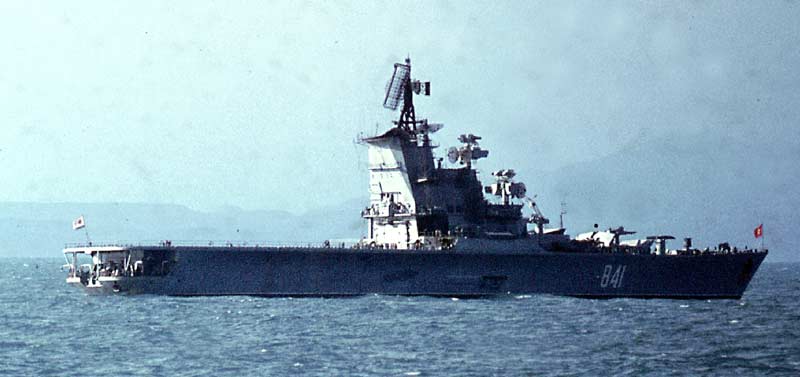
On March 1, 1973 made her fifth Mediterranean deployment over 83-days and 19,910 miles, visiting Alexandria and provided assistance to the Egyptian Armed Forces during the Yom Kippur war. August 7, 1973, saw her chosen to film “Ocean” over 5 days. April 24, 1974 was the start of hr 6th deployment in the Mediterranean over 67-day, 13,717 miles and visiting Rijeka in Yugoslavia, the largest ship ever to enter the port.
On February 2, 1975, while in the roadstead of the Northern Bay of Sevastopol, she experienced a massive fire starting in her anti-ship missile bay after a short circuit. The adjacent bow diesel generators, No. 3 post and power compartment No. 1 as most of her bow compartments burned out completely. This fire was only mastered after 7 hours, despite the systems in place. Three crew members died from carbon monoxide poisoning.
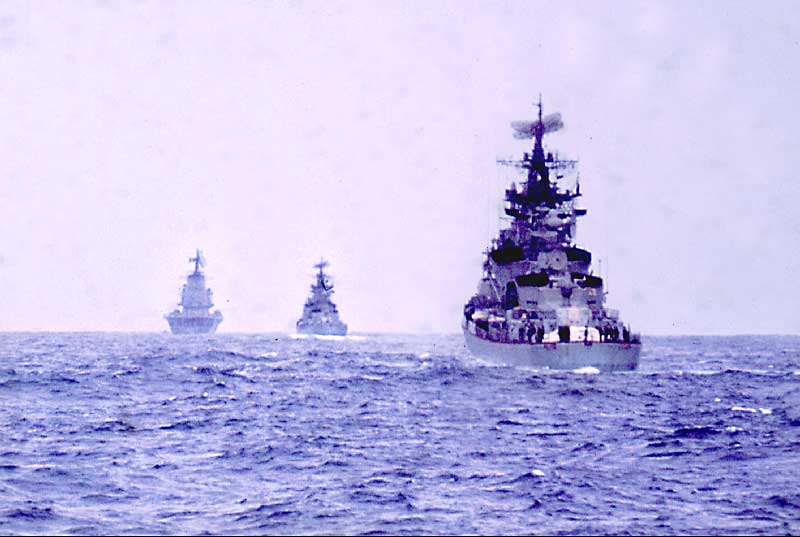
In the Mediterranean January 1970
On February 19, 1975 repair started at Nikolaev No. 198 yard, followed by her major overhaul and modernization. On December 26, 1976 she left for Sevastopol, assigned to the 11th ASW brigade, 30th division, and maed a refresher cruiser plus weapons, sensors and helicopter qualifications. November 21, 1977 saw her starting her 7th Mediterranean 221-day cruise over 20,509 miles, visiting Algiers. On August 25 1979 (renamed 104, and later 100) made her eighth Mediterranean deployment over 190-day, 16,307 miles, visiting Dubrovnik in Yugoslavia.
On June 4, 1980 a navigation error had her running aground near Sevastopol, damaging her Orion sonar..
On March 5, 1981 after repairs she started her 9th combat deployment with the 5th brigade as flagship in the Mediterranean, 154-day and 12,840 miles and another port visit to Dubrovnik (now in Croatia).
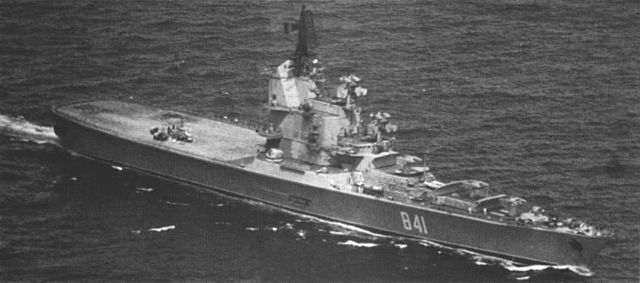
On 25 February 1982 she started her 10th Mediterranean-Atlantic cruiser, 160-day, 20,058 miles, stoping at Rijeka (Yugoslavia), and transiting via Gibraltar she sailed to the southern Atlantic, stopping at Luanda in friendly Angola at war with South Africa, as well as in Lagos, Nigeria. October 1, 1982 saw her drydocked for a second and last overhaul and modernization at Sevmorzavod, S. Ordzhonikidze No. 201 yard in Sevastopol.
On June 18, 1990 she made a refresher cruiser and qualifications. October 14, 1991 saw her maker her 11th and last Mediterranean cruiser, 49 days, 3,253 miles and stopping in Tartus, Syria. On January 27, 1992 she hosted the commander of the Red Black Sea Fleet, Admiral I. V. Kasatonov, when sailing to Novorossiysk, where she was visited by President B. N. Yeltsin and Minister of Defense, Air Marshal E. I. Shaposhnikov. She later took part in Black Sea fleet exercizes. On May 26, 1993, she made a last deployment in the Black Sea and by 1994, she was mothballed in the Northern Bay of Sevastopol. On April 27, 1995 she was rated in the 2nd category reserve, unnamed by June 2, 1995, her hull called “PKR No. 108”.
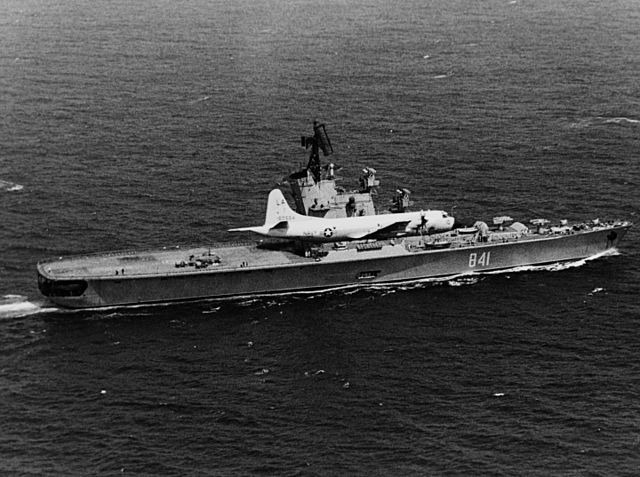
Flew over by a P3 Orion in 1970
For the 300th anniversary of the Russian Fleet, she was decommissioned, stricken on November 7, 1996. She was Sold for scrap to India, leaving under tow on May 27 and ended in Alang.
Her name was freed for the new (Slava class) Project 1164 which became on April 14, 2022 flagship of the Black Sea Fleet.
 Leningrad
Leningrad
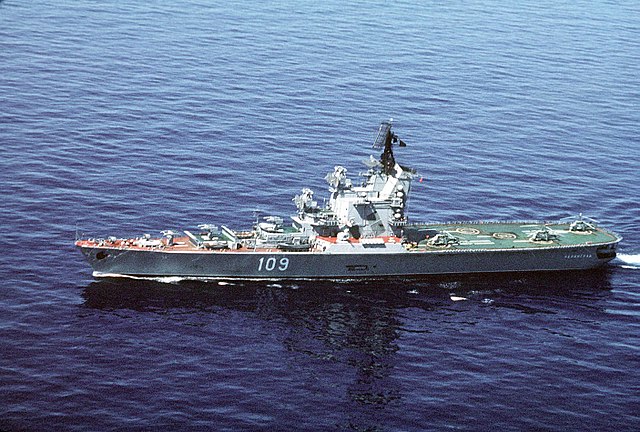
Leningrad was laid down at the Black Sea Yard 702 in Nikolayev, 15 January 1965, launched on 31 July 1966, completed on 24 January 1967, and commissioned 2 June 1969. After transfer to the fleet and full acceptance she was assigned to the 21st ASW brigade of the Black Sea Fleet as flagship. On March 20, 1970, under the number 848, she started her first Mediterranean Sea/Atlantic Ocean cruise which lasted for 77-day over 20,000 miles also taking part in “Ocean-70” with her sister Moskva. This was the largest soviet navy exercize and the only time both ships participated together.
Later it became common to alternate both cruisers in the Mediterranean to ensure always a 200+ days of presence of at least one helicopter cruiser.

Leningrad in the 1970s
On August 4, 1971, Leningrad hosted the General Secretary of the Central Committee L. I. Brezhnev and Politburo, Minister of Defense A. A. Grechko, CiC Admiral S. G. Gorshkov and leaders of five countries from Poland, East Germany, Romania, Bulgaria and Albania to witness large scale exercizes. The delegation stayed onboard from Sevastopol to Yalta so see fire demonstration of the RPK-1 Vikhr, RBU-6000 and AK-725.
In September 1971, Leningrad departed for her second Mediterranean-Atlantic cruiser over 212-day, visiting Alexandria, taking part in exercises “Yug-71” and “Vympel”, and the rescue of the famous “K-19” (first Soviet ballistic nuclear submarine of Project 658) in the Atlantic, accompanied to Severomorsk (see the 2002 movie K-19: The Widowmaker for more).
On May 26, 1972, she entered Sevastopol drydock, Sevmorzavod S. Ordzhonikidze, No. 201 for an overhaul.
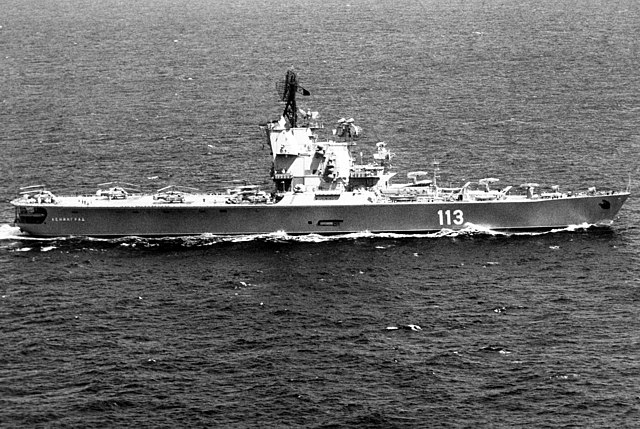
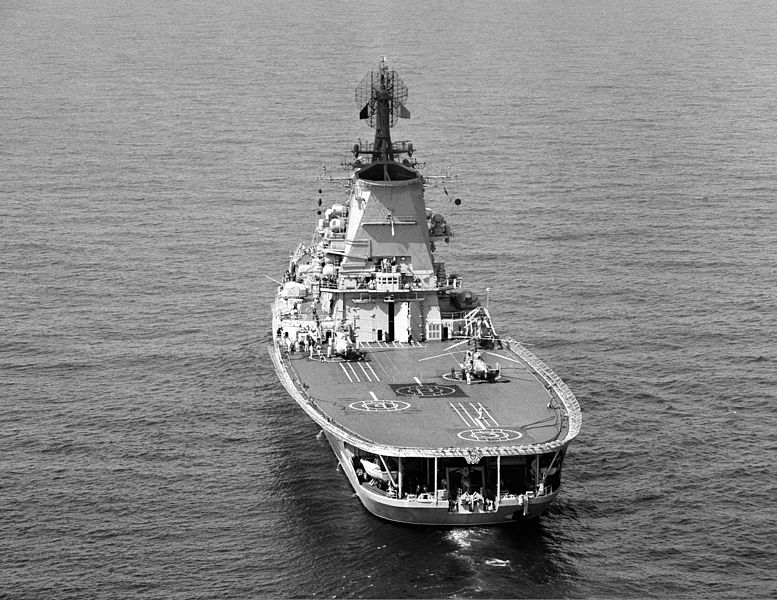
In 1974 for the first time she took part in active combat operations clearing mines in the Gulf of Suez, and returned to Sevastopol on December 6, 1974, after visiting Berbera in Somalia, Port Louis in Mauritius, Malabo in Equatorial Guinea and Dakar in Senegal along the way.
In 1975 and 1976, she had another six months deployment in the Mediterranean, visiting Alexandria on August 4-7, 1975 and Dubrovnik on October 30 to November 5, 1975, and Split in October 14-19, 1976.
After maintenance at Nikolaev between April 10, 1977 and September 18, 1978 she made a two-month Mediterranean deployment from July 1 to August 31, 1979 and started another atlantic cruise, to Europe and the Baltic and back, combined with a major exercise. This started on February 28 and ended by August 26, 1980. In June, she was anchored on Neva, as first and last visit of her namesake city.
On August 1, 1981, she left Sevastopol for Leningrad again, taking part in the Zapad-81 exercise from August 15 to September 16, monitoring foreign submarines in the Mediterranean and later visited El Jazair in Algeria and back home on March 5, 1982.
For her 14th sortie between February 22 and June 16, 1984 she ventured into the Atlantic, sailing escorted by the North Sea destroyer Udaloy and tanker “Golden Horn”. They crossed the Atlantic to Cuba, stayed in Havana from March 26-30 and took part in Soviet-Cuban maneuvers in the Gulf of Mexico, then Zaslon-84 SSN search exercise on open ocean.
Her next deployment between August 18 and November 6, 1984 was with the destroyer “Krazny Krim” and support vessels to clear off mines in the Red Sea, off the coast of Yemen and Ethiopia. Spotting was performed by Mi-14 and Ka-25 helicopters as well as disposal. She later visuted Aden, Yemen, by September 8-28. That was a busy year.
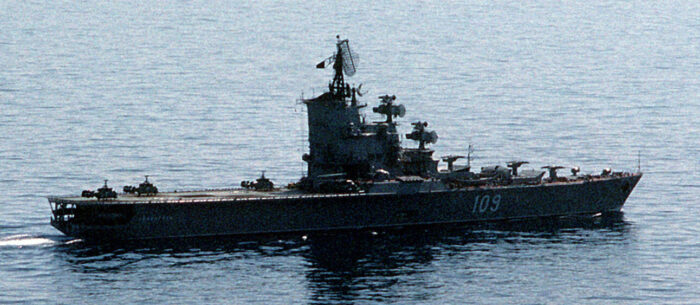
When back she was drydock for well deserved overhaul at Sevmorzavod between August 5 and September 9, 1985 and at Nikolaev between December 25, and August 25, 1987, performed a refrseher traning, all qualifications before her last two Mediterranean cruises, between November 26, 1988 and 15 June 1989, and between March 15 and June 22, 1990. She was supposed to benefit from a full modernization but given the state of USSR at the time, it was never carried out.
Leningrad was decommissioned on June 24, 1991, stricken on December 5, 1992 in presence of fleet Admiral I.V. Kasatonov, and towed to Northern Bay, Troitskaya Balka berth, remaining there for several more years. On August 24, 1995, sold, she was towed to Alang to be broken up.
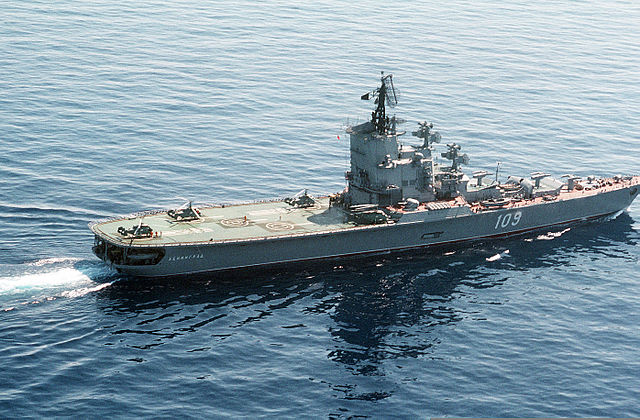
Leningrad in 1970
Read More/Src
Books
Gardiner, Robert, ed. (1995). Conway’s All the World’s Fighting Ships 1947–1995. London: Conway Maritime.
Gardiner, Robert; Chumbley, Stephen; Budzbon, Przemysław (1995). Conway’s All the World’s Fighting Ships 1947–1995. NIP
Balakin S. A., Zablotsky V. P. Soviet aircraft carriers. Aircraft carrier cruisers of Admiral Gorshkov. – Moscow: Yauza, EKSMO, 2007.
E. I. Vostokov. Greeks. 2nd ed., add. M., Voenizdat, 1983.
Links
cimsec.org/the-moskva-class-helicopter-cruiser
On ru.wikipedia.org
hazegray.org/
wiki
Ak-725 AA guns RU
ru.wikipedia.org 45-mm semi-automatic naval gun 21-K (21-KM)
Vikhr ASUW missile system RU
navweaps.com/ soviet torpedoes
Project 1123. Access date: January 30, 2013. Archived from the original on November 9, 2013.
BOD “Red Crimea”. Retrieved November 10, 2013. Archived November 10, 2013.
Naval flag – article from the Great Soviet Encyclopedia.
Trinity beam. Retrieved November 10, 2013. Archived from the original on November 10, 2013.
Alang. Where ships die. Archived November 10, 2013.
Videos
3D
Note: First Published on Jan 20, 2018.

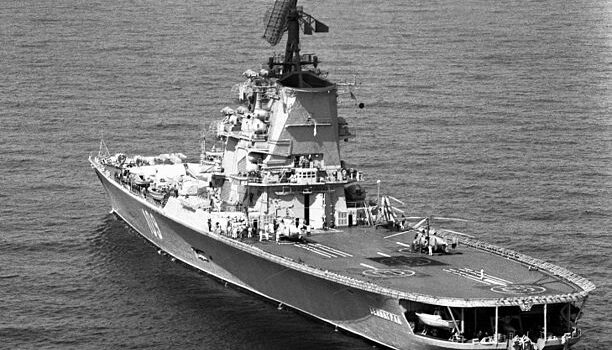

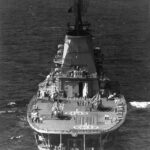
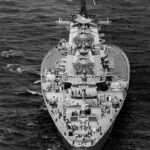
 Latest Facebook Entry -
Latest Facebook Entry -  X(Tweeter) Naval Encyclopedia's deck archive
X(Tweeter) Naval Encyclopedia's deck archive Instagram (@navalencyc)
Instagram (@navalencyc)





 French Navy
French Navy Royal Navy
Royal Navy Russian Navy
Russian Navy Armada Espanola
Armada Espanola Austrian Navy
Austrian Navy K.u.K. Kriegsmarine
K.u.K. Kriegsmarine Dansk Marine
Dansk Marine Nautiko Hellenon
Nautiko Hellenon Koninklije Marine 1870
Koninklije Marine 1870 Marinha do Brasil
Marinha do Brasil Osmanlı Donanması
Osmanlı Donanması Marina Do Peru
Marina Do Peru Marinha do Portugal
Marinha do Portugal Regia Marina 1870
Regia Marina 1870 Nihhon Kaigun 1870
Nihhon Kaigun 1870 Preußische Marine 1870
Preußische Marine 1870 Russkiy Flot 1870
Russkiy Flot 1870 Svenska marinen
Svenska marinen Søværnet
Søværnet Union Navy
Union Navy Confederate Navy
Confederate Navy Armada de Argentina
Armada de Argentina Imperial Chinese Navy
Imperial Chinese Navy Marinha do Portugal
Marinha do Portugal Mexico
Mexico Kaiserliche Marine
Kaiserliche Marine 1898 US Navy
1898 US Navy Sovietskiy Flot
Sovietskiy Flot Royal Canadian Navy
Royal Canadian Navy Royal Australian Navy
Royal Australian Navy RNZN Fleet
RNZN Fleet Chinese Navy 1937
Chinese Navy 1937 Kriegsmarine
Kriegsmarine Chilean Navy
Chilean Navy Danish Navy
Danish Navy Finnish Navy
Finnish Navy Hellenic Navy
Hellenic Navy Polish Navy
Polish Navy Romanian Navy
Romanian Navy Turkish Navy
Turkish Navy Royal Yugoslav Navy
Royal Yugoslav Navy Royal Thai Navy
Royal Thai Navy Minor Navies
Minor Navies Albania
Albania Austria
Austria Belgium
Belgium Columbia
Columbia Costa Rica
Costa Rica Cuba
Cuba Czechoslovakia
Czechoslovakia Dominican Republic
Dominican Republic Haiti
Haiti Hungary
Hungary Honduras
Honduras Estonia
Estonia Iceland
Iceland Eire
Eire Equador
Equador Iran
Iran Iraq
Iraq Latvia
Latvia Liberia
Liberia Lithuania
Lithuania Mandchukuo
Mandchukuo Morocco
Morocco Nicaragua
Nicaragua Persia
Persia San Salvador
San Salvador Sarawak
Sarawak Uruguay
Uruguay Venezuela
Venezuela Zanzibar
Zanzibar Warsaw Pact Navies
Warsaw Pact Navies Bulgaria
Bulgaria Hungary
Hungary

 Bundesmarine
Bundesmarine Dutch Navy
Dutch Navy Hellenic Navy
Hellenic Navy Marina Militare
Marina Militare Yugoslav Navy
Yugoslav Navy Chinese Navy
Chinese Navy Indian Navy
Indian Navy Indonesian Navy
Indonesian Navy JMSDF
JMSDF North Korean Navy
North Korean Navy Pakistani Navy
Pakistani Navy Philippines Navy
Philippines Navy ROKN
ROKN Rep. of Singapore Navy
Rep. of Singapore Navy Taiwanese Navy
Taiwanese Navy IDF Navy
IDF Navy Saudi Navy
Saudi Navy Royal New Zealand Navy
Royal New Zealand Navy Egyptian Navy
Egyptian Navy South African Navy
South African Navy






























 Ukrainian Navy
Ukrainian Navy dbodesign
dbodesign